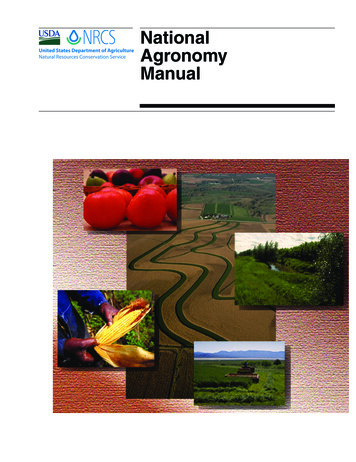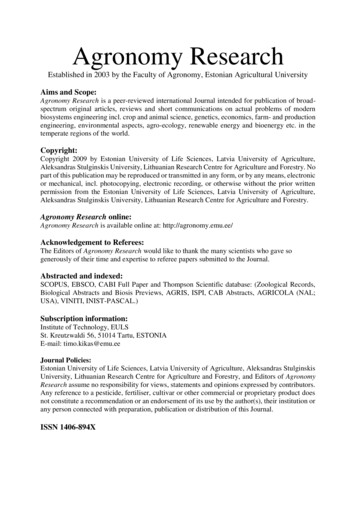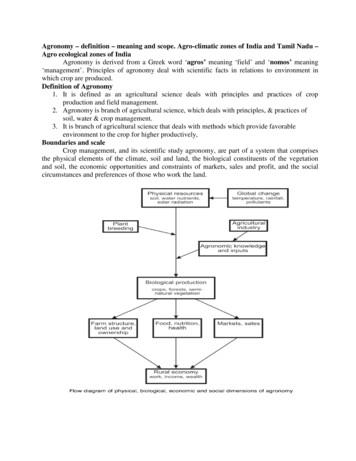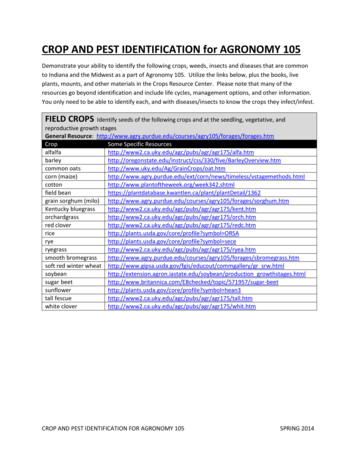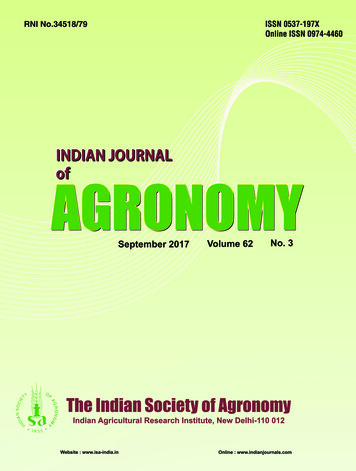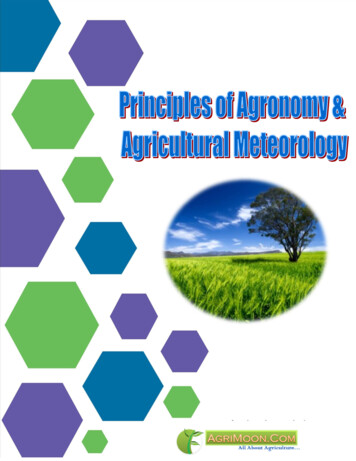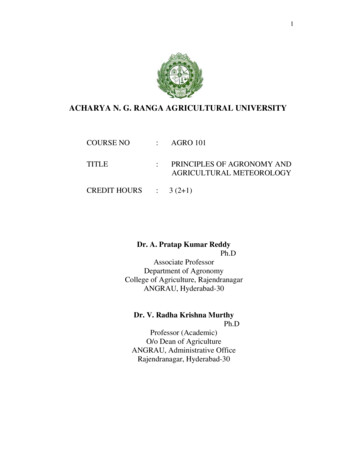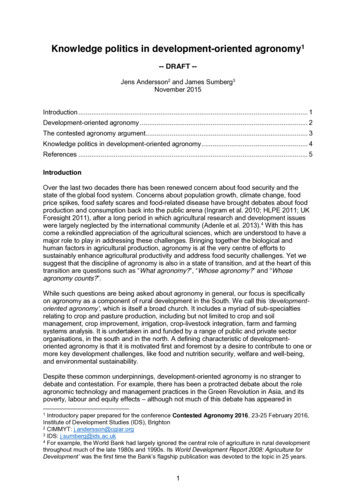
Transcription
Agronomy JournalVolume 96January–February 2004Number 1FORUMCrop and Soil Productivity Response to Corn Residue Removal: A Literature ReviewW. W. Wilhelm,* J. M. F. Johnson, J. L. Hatfield, W. B. Voorhees, and D. R. LindenABSTRACTof greenhouse gases in the atmosphere (IPCC, 2001),and ability of our agricultural systems to sustain production at rates needed to feed a growing world population(Cassman, 1999). Many papers have been written onthese topics both individually and in the various combinations (Doran, 2002; Follett, 2001; Janzen et al., 1998a,1998b; Lal et al., 1999). However, few authors have addressed all three topics together.Recent developments in the energy industry and activity by entrepreneurs have prompted new strategiesfor addressing the first issue, overreliance on importedfuels (Hettenhaus et al., 2000). This strategy expands useof biomass for fuel production and is contingent on development of new organisms or enzymes to convertcellulosic (a high concentration of cellulose) biomass[opposed to grain (starchy) biomass] to ethanol for useas a motor vehicle fuel. The U.S. DOE, in concert withprivate enterprise, is making great strides toward developing enzymes and improving efficiency in fuel production from biomass (DiPardo, 2000; Hettenhaus et al.,2000).Sources of cellulosic biomass are numerous (woody biomass crops and lumber industry wastes, forage crops, industrial and municipal wastes, animal manure, and cropresidues); however, currently few sources are perceivedto be available in sufficient quantity and quality to support development of an economically sized processingfacility of about 1800 Mg dry matter d 1 (Hettenhauset al., 2000), except crop residues (DiPardo, 2000). Bagasse [remaining after sap extraction from sugarcane(Saccharum officinarum L.)] in Louisiana and rice (Oryza sativa L.) straw in California are regional examplesof crop residues collected in current culture and available for production of ethanol (DiPardo, 2000). Creating an acceptable use or disposal procedure for theseresidues represents a huge problem in the regions wherethey are produced although the total quantity is notsufficient to have a great impact on fuel needs for thenation (DiPardo, 2000). On the other hand, the quantityof corn stover is large, but corn stover is generally notSociety is facing three related issues: overreliance on imported fuel,increasing levels of greenhouse gases in the atmosphere, and producing sufficient food for a growing world population. The U.S. Department of Energy and private enterprise are developing technologynecessary to use high-cellulose feedstock, such as crop residues, forethanol production. Corn (Zea mays L.) residue can provide about1.7 times more C than barley (Hordeum vulgare L.), oat (Avena sativaL.), sorghum [Sorghum bicolor (L.) Moench], soybean [Glycine max(L.) Merr.], sunflower (Helianthus annuus L.), and wheat (Triticumaestivum L.) residues based on production levels. Removal of cropresidue from the field must be balanced against impacting the environment (soil erosion), maintaining soil organic matter levels, and preserving or enhancing productivity. Our objective is to summarize published works for potential impacts of wide-scale, corn stover collectionon corn production capacity in Corn Belt soils. We address the issue ofcrop yield (sustainability) and related soil processes directly. However,scarcity of data requires us to deal with the issue of greenhouse gasesindirectly and by inference. All ramifications of new management practices and crop uses must be explored and evaluated fully before anindustry is established. Our conclusion is that within limits, corn stovercan be harvested for ethanol production to provide a renewable, domestic source of energy that reduces greenhouse gases. Recommendation for removal rates will vary based on regional yield, climaticconditions, and cultural practices. Agronomists are challenged to develop a procedure (tool) for recommending maximum permissibleremoval rates that ensure sustained soil productivity.Three of the most pressing issues facing our society,in the midterm, are overreliance on imported fuels[U.S. Department of Energy (DOE) Office of Energy Efficiency and Renewable Energy, 2002], increasing levelsW.W. Wilhelm, USDA-ARS, 120 Keim Hall, Univ. of Nebraska, Lincoln, NE 68583-0934; J.M.F. Johnson, USDA-ARS, 803 Iowa Ave.,Morris, MN 56267-1065; J.L. Hatfield, 108 Natl. Soil Tilth Lab., 2150Pammel Drive, Ames, IA 50011-3120; W.B. Voorhees, USDA-ARS(retired), 803 Iowa Ave., Morris, MN 56267-1065; and D.R. Linden,USDA-ARS (retired), 1991 Upper Buford Circle, St. Paul, MN 551080000. This paper is a joint contribution of the USDA-ARS and theAgricultural Research Division of the University of Nebraska. Published as Journal Ser. no. 13949. Received 12 Dec. 2002. *Corresponding author (wwilhelm1@unl.edu).Abbreviations: 13C, change in 13C atom percent; DOE, Departmentof Energy; HI, harvest index; SOC, soil organic carbon; SOM, soilorganic matter.Published in Agron. J. 96:1–17 (2004). American Society of Agronomy677 S. Segoe Rd., Madison, WI 53711 USA1
2AGRONOMY JOURNAL, VOL. 96, JANUARY–FEBRUARY 2004Table 1. Grain production and estimated residue production forthe four largest corn grain production states and the U.S. totalfor the 2000 crop year.StateIowaIllinoisNebraskaMinnesotaFour state totalU.S. totalGrain yield† Harvest index‡ Stover 00.500.50Tg44.342.525.824.4136.9253.7Fraction ofU.S. total0.1750.1680.1020.0960.5411.000† Data from Natl. Agric. Stat. Serv. (2000).‡ Harvest index grain yield/(grain yield stover yield).§ Tg 1012 g.collected in the normal cultural practices employed forgrain production in the Corn Belt.Based on grain production for the 2000 crop year (National Agricultural Statistics Service, 2000) and a conservative harvest index [HI, grain yield/(grain yield stoveryield)] of 0.50 (Linden et al., 2000), total stover production for the four states with the greatest corn grain production (Iowa, Illinois, Nebraska, and Minnesota) wasabout 137 Tg (1012 g) (Table 1). Certainly, only a relatively small portion of this residue would be availableas a feedstock; but if all were available, the residue inIowa alone (44.3 Tg) could supply more than sixty 1800Mg d 1 plants defined in DOE analyses (Hettenhauset al., 2000). Using the ethanol yield (conversion efficiency) of 300 L Mg 1 stover (McAloon et al., 2000)gives a daily output of 540 kL industrial plant 1 or anannual production potential from Iowa stover of 10.7GL (109 L). Analyses by DOE assume an industrialplant will produce ethanol for 330 d yr 1 and be offline for maintenance during the other 35 d (McAloonet al., 2000). The actual amount of feedstock (stover)that could be removed has been estimated from 20%(Nelson, 2002) to about 30% (McAloon et al., 2000) ofthe total based on the need for adequate soil cover tocontrol soil erosion. If 30% of the feedstock is used,Iowa has the potential to supply 3.57 GL of ethanol.This is slightly less than the 4.21 GL of U.S. motorfuel ethanol consumption for 2000 (Energy InformationAdministration, 2002). With these facts and assumptionsin mind, DOE has targeted development of biomassethanol production based on corn stover as a feedstock.The calculations outlined above indicate corn stoverproduced in Iowa may have the potential to meet current ethanol use for motor fuels, but this productioncapacity will have little impact in meeting total U.S.motor fuel needs (both ethanol and nonethanol consumption), estimated to be 617 GL in 2000 (EnergyInformation Administration, 2002). The 3.57 GL of potential production from Iowa corn residue representsonly 0.6% of the 617 GL of motor fuel used in the USAin 2000. However, stover production in Iowa representsless than 20% of the total U.S. corn crop, and corn isonly one of many crop residues that could be collectedand used for biomass ethanol production. Nelson (2002)used agricultural statistics from 1995 to 1997 to estimatethat 42 Tg of corn stover and 8 Tg of wheat straw couldbe removed in 37 states, without exceeding tolerablesoil erosion levels. Ethanol production from agriculturalresidues has the potential to be a viable component inthe plan to reduce U.S. reliance on imported fossil fuels.The second issue, increasing levels of greenhousegases in the atmosphere, has received extensive publicityin the popular press and scientific literature. The KyotoSummit propelled discussions of greenhouse gas effectson global climate and the role various human activitiesplay in producing or consuming these gases. Agricultural practices have been cited as both sources and sinksfor greenhouse gases, especially CO2 (Follett, 2001; Lalet al., 1999). Crop residues and soil organic matter (SOM)represent a significant portion of total terrestrial C.Many of our traditional crop cultural practices (i.e., tillage, fallow, etc.) have resulted in release of old (relic)soil C into the atmosphere by increasing the rate ofSOM decomposition (Bauer and Black, 1981; Haas etal., 1957; Janzen et al., 1998b) or decreasing organicmatter input. Over decades of crop production in theU.S. Corn Belt and Great Plains, organic matter originally contained in these soils was lost through accelerated decomposition and erosion (Doran et al., 1998;Follett, 2001). Lal et al. (1999) indicated that with appropriate changes in crop management practices such asconservation tillage and irrigation and reducing or eliminating fallow and increasing the amount of crop residuereturned to the soil, SOM content could be increased.Implicit is that increasing SOM also decreases atmosphere C pools. In fact, efforts have been initiated todevelop markets for crop producers using C-sequestering cultural practices to sell C credits.The last issue, sustaining the ability of crop production systems to generate sufficient food for a growingworld population, is extremely complex. Practices thatreduce the productive potential of our soils undermineour efforts to provide food and fiber for an expandingworld population. Continued crop production potentialof soils has a direct relationship to its organic mattercontent (Doran et al., 1994; Lal, 1998; Mann et al., 2002).Within limits, productivity is positively related to theSOM content (Reicosky and Forcella, 1988).Many of the characteristics of highly productive soilsrelate to the organic fraction of the soil (Doran et al.,1998; Doran, 2002; Janzen et al., 1998a). Organic matterimparts numerous positive characteristics to soil. Somerelate to soil physical and chemical properties, but allrevolve around the dynamics of organic matter decomposition by soil organisms (Albrecht, 1938; Franzluebbers, 2002). The primary physical characteristic influenced by SOM is soil structure through soil aggregationand aggregate stability (Tisdall and Oades, 1982; Sixet al., 1999). In turn, aggregates and their stability havetremendous influence on infiltration of water, soil waterholding capacity, and aeration as well as bulk densityand penetration resistance and the more ill-defined characteristic, soil tilth (Carter, 2002). Chemical propertiesthat at least partly depend on SOM include pH, nutrientavailability and cycling, ion exchange capacity, and buffering capacity (Tisdall et al., 1986). Follett (2001) indicated that if all other factors are constant, SOM contentis dictated by the quantity of residue returned to the
WILHELM ET AL.: IMPACTS OF CORN RESIDUE REMOVALsoil. Therefore, it is logical to deduce that if residue isremoved, SOM will decline if other cultural practicesare not modified simultaneously to reduce decomposition and other losses to offset the change in organicmatter entering the system.Crop residues are important in the formation of SOM.In addition, residue buffers soil against the forces ofraindrop impact and wind shear. Crop residues on thesoil surface strongly influence radiation balance andenergy fluxes and reduce the rate of evaporation fromthe soil. Therefore, they traditionally have been usedas a soil amendment for erosion control (Gilley et al.,1986; Gregorich et al., 1998, Soil Conserv. Soc. of Am.,1979). Erosion decreases productivity by removing theorganic-matter–rich topsoil. Any removal of crop residue must be limited by the need to retain sufficient soilcover to keep soil loss by erosion within tolerable limitsestablished by NRCS (Larson, 1979; Nelson, 2002). TheT values currently used for erosion tolerance do not necessarily provide an adequate level of protection to prevent environmental degradation and yield loss (Mannet al., 2002).Distribution of corn production either as continuouscorn or in rotation with soybean for the Midwest is shownin Fig. 1. Intense corn production is centered in the central United States. When these data are coupled with landresource data on which this corn is produced (Fig. 2), itis obvious that a large amount of the land in the intenseproduction area is classified as highly erodible. Crop production on highly erodible land must occur while maintaining adequate crop or residue cover to protect thesoil resource against erosion. In the 2000 crop residuesurvey gathered by the Conservation Technology Information Center, 36% of the land in corn production inthe Midwest was farmed with some form of conservationtillage (Conserv. Technol. Inf. Cent., 2002). The collec-Fig. 1. Corn production in the United States (USDA, 1995).3tion of corn stover for use as a bioethanol feedstockmust be limited to accommodate the other objectivesfor residue within the production system and considerthe current soil conservation measures used on a siteby-site basis. One of the most important, but certainlynot the only need, is erosion protection.Use of corn residue for production of ethanol has theadvantages of reducing dependence on imported fossilfuel and developing a renewable energy source (as discussed above). Others include reducing the release ofgreenhouse gases from fossil fuels, stimulating the farmeconomy and rural communities, and removing or minimizing obstacles to crop production such as reducinginsects and diseases in future crops through eliminationof overwintering sites and sources of infection. Researchfrom the central and northern Corn Belt (Kaspar et al.,1990; Swan et al., 1994) indicated that removing residuein total, or only moving it away from the planted row,could increase grain yield.Our objective for this paper is to summarize our previous work in combination with other published workson the impacts that wide-scale collection of corn stovermay have on corn production capacity of Corn Belt soils.We address the issue of crop yield (sustainability) andrelated soil processes directly, but the issue of greenhouse gases will largely be dealt with indirectly and byinference. We emphasize at the outset that we neithersupport nor oppose use of corn stover for productionof ethanol as a matter of principal but rather think itabsolutely essential that all ramifications of new management practices and crop uses be explored and evaluated fully before an industry is established. As researchers directly associated with agricultural producers, weare keenly aware of the need for growers to have newsources of income if they are to sustain their enterprises.However, as a society concerned about the sustainability
4AGRONOMY JOURNAL, VOL. 96, JANUARY–FEBRUARY 2004Fig. 2. Corn production on land classified as highly erodible land by NRCS (USDA, 1995).of food, feed, and fiber production capacity and thequality of our environment, we must guard against public policy and industrial decisions based on partial information. The worst action for society would be for actionson the part of government or industry to address nearterm problems (overreliance on imported fossil fuelsand low farm incomes) that may only aggravate longterm problems (reduction in production capacity of ourfarmland soils).In this paper, we use the terms SOM and soil organicC (SOC) frequently. In many cases, the terms can beinterchanged without loss of meaning, such as the statement that SOM is positively related to the amount ofresidue returned to the soil (Maskina et al., 1993). Thisgeneral relationship is very likely true for SOC, too.However, since the authors measured and reportedSOM, we use SOM in this paper. In other cases, authorsmay have measured and reported only SOC. In thislatter case, we report only SOC. In some cases, authorsmay have used the terms interchangeably. The termSOC is more specific than SOM because it discriminatesbetween organic and inorganic C in the soil and includesonly the mass of C in the material, not O, H, N, P, S,etc., that may also be part of SOM. We apologize forany confusion the similarity in terms may cause thereader but feel it necessary to report data and conclusions as they appear in the literature.We use three terms to describe all, or part, of the aboveground, nongrain part of a corn plant: cornstalk, stover,and residue. In this paper, we define cornstalk as the mature central axis of the plant (i.e., the culm), which iscomposed of nodes and internodes. Stover and residueare both terms that include all of the aboveground partsof the corn plant (stalk, leaves, cobs, and husk) thatremain in the field after grain harvest. The crown andsurface (brace) roots are not included in our definitionof stover. As we use these terms, stover is this above-ground material before it has weathered or been incorporated into the soil by vehicle or animal traffic or natural action of wind, rain, ice, and snow. Residue is theaboveground, nongrain parts of the corn plant that havebeen weathered and/or partly incorporated into the soilsurface by natural events or human or animal activity.RESIDUE MANAGEMENT IMPACT ONCROP YIELDCrop residues clearly influence crop production. Inan experiment conducted over 3 yr under rainfed conditions in eastern Nebraska, 0, 50, 100, or 150% (dryweight basis) of the residue produced by the previouscrop was returned to the soil. A portion of the residuefrom the 0 and 50% rates was added to achieve the150% rate. For each megagram per hectare of the previous corn crop’s residue removed, grain yield of the current crop was reduced 0.13 Mg ha 1, and biomass yieldwas reduced 0.29 Mg ha 1 (Wilhelm et al., 1986). Theserelationships were essentially the same for soybean residue removal: Soybean grain yield was reduced 0.09 Mgha 1, and grain yield was reduced 0.30 Mg ha 1. Thereduction in yield was attributed to reduced water availability and increased soil temperature.In a 3-yr follow-on study to Wilhelm et al. (1986),Maskina et al. (1993) reported that returning 0, 50, 100,and 150% of the residue produced by the previous cropto the soil resulted in SOM contents (to 30 cm) of 24.7,25.3, 26.2, and 27.4 g kg 1, respectively. In addition,during the latter 3-yr study (when residue treatmentshad been discontinued; that is, all crop residues werereturned to the plots where they were produced), corngrain and residue yields still differed between the 0 and150% rates by about 750 kg ha 1 (Maskina et al., 1993).Again, the authors attributed the greater production inthe plots previously treated with 150% residue rate to
WILHELM ET AL.: IMPACTS OF CORN RESIDUE REMOVALimproved water relations in the soil for both plantgrowth and microbial activity, which enhanced nutrientcycling. Power et al. (1998) indicated that the positiveyield response to differential residue applications received 10 yr earlier in the Wilhelm et al. (1986) studywas still apparent, with no evidence of decline. Poweret al. (1998) suggested that the positive influence of residue applications was caused by changes in soil properties, such as SOM and N cycling. Barber (1979) reportedthat SOM levels (11 yr after initiation of treatments)were similar for the fallow and residue removal treatment, which were both less than the SOM level for theresidue-returned treatment, which, in turn, was less thanthe SOM in the double-residue treatment. In contrastto the work reported in the series of papers by Wilhelmand coworkers (Wilhelm et al., 1986; Maskina et al.,1993; Power et al., 1998), Barber (1979), working inIndiana, reported no change in corn yield as a result of6 yr of fallow, residue removal, all residue returned, ordouble residue returned. Wilts et al. (unpublished, 2004),averaging yields over a 29-yr period from a site in Minnesota, reported no differences in biomass productionbetween plots where silage was removed annually compared with plots where only grain was harvested. Thisapparent contradiction in yield response may be a resultof contrasting tillage practices employed among experiments as suggested by Allmaras et al. (2000) and thedifferent environments characterizing the eastern andwestern Corn Belt. In the work by Wilhelm and coworkers (Wilhelm et al., 1986; Maskina et al., 1993; Poweret al., 1998), corn was grown without tillage or irrigationin Nebraska while Barber (1979) used a moldboard plowfor primary tillage and in-season cultivation as part ofthe weed control regime in his study in Indiana andWilts et al. (unpublished, 2004), in Minnesota, also useda moldboard plow for primary tillage. As the data inthis paragraph and logic would suggest, changes in SOCare proportional to the amount of crop residue returnedto the soil (Larson et al., 1972), but tillage system influences SOC retention (Linden et al., unpublished, 2004).Current SOC content is a result of the balance betweeninputs and output (decomposition and other loss processes). The value of SOM lies in its dynamics. Soil ismore productive if SOM is regularly added and subsequently decomposed. In these processes, nutrients andC are cycled and structure maintained or enhanced (Albrecht, 1938).Parton and Rasmussen (1994) also showed a linearrelationship between aboveground input of C and thechange in soil C over time. This was expressed as soilC (g m 2 yr 1) 0.34 0.18 aboveground C input(g m 2 yr 1) for their observed data points. Paustianet al. (1992), using the CENTURY model, showed therewas a positive, linear relationship across a range of different soil treatments between C input and change inSOC using 30 yr of data. Results of this modeling exercise are consistent with field observations on wheat byRasmussen et al. (1980) and Parton and Rasmussen(1994) and on corn by Maskina et al. (1993), Barber(1979), and Larson et al. (1972).Recently, Linden et al. (2000) reported results of a13-yr study of the influence of tillage, N fertilization, and5residue removal on corn grain and biomass production.During 8 of the 13 yr, residue treatment (removed orreturned to the soil) affected yield. Over the course ofthe study, stover yield averaged 4.80 Mg ha 1 for theresidue-removed treatment compared with 5.24 Mg ha 1for the residue-returned treatment. They also reportedthat HI did not differ among treatments and averaged0.56 for their study but was sensitive to weather differences among years. Harvest index was low when totalbiomass (grain plus stover) yield was low. Computinggrain yield from the stover yield and HI data, the residue-removed treatment produced an average of 6.10Mg grain ha 1, and the residue-returned treatment produced 6.67 Mg grain ha 1. Production was lower withno tillage than with the tilled treatments. When residuewas returned and N fertilizer applied, differences amongtillage treatments were reduced but not eliminated. Ina companion study, Clapp et al. (2000) reported that13 yr of stover harvest did not affect SOC in the surface0 to 15 cm compared with the residue-returned treatment if the plots were tilled annually (moldboard orchisel-plowed) and had low N input. In contrast, whenstover was returned on no-till plots, the SOC in the surface 30 cm increased 14%. When fertilizer N was appliedand the residue returned, the soil consistently had moreSOC compared with the residue-harvested treatmentsregardless of tillage. Clapp et al. (2000) also reportedthat the combination of returning stover and adding Nfertilizer slowed decomposition of relic SOC while thecombination of removing stover and adding N increasedthe decomposition of relic SOC.Tillage and crop residue management effects on cornyield and soil quality (SOC) has been studied extensively over many years. Unfortunately, most of thesereports have been from short-term studies that onlysuggest what would occur over the course of 1 or 2 yr(Cassel et al., 1995; Karlen et al., 1984) but fall short ofindicating what might happen under long-term continuation of these management practices (Dick et al., 1998).Short-term studies also do not account for variation inweather conditions over extended periods nor are theylong enough for measurable changes in SOC to occur(Karlen et al., 1994; Linden et al., unpublished, 2004;Wilts et al., unpublished, 2004). Reports of results fromlong-term studies have been published recently byAngers et al. (1995), Dick et al. (1998), and West andPost (2002). Dick et al. (1998) and West and Post (2002)reported that tillage was an important factor in determining change in SOC, but Angers et al. (1995) foundthat incorporation of corn-derived C into SOM was notaffected by tillage. Dick et al. (1998) and West and Post(2002) indicated that rotations impacted C sequestrationmainly through changing C input. Dick et al. (1998)stated that residue removal was less important thantillage or rotation for changing C sequestration.Tillage and residue management variations create acomplex association of soil and surface conditions thatboth directly and indirectly influence the performanceof a crop such as corn. For example, crop residue coverage has been observed to decrease yields because of poorweed control, excessively wet and cold soils, and poorseed placement and stand (Swan et al., 1994). On the
6AGRONOMY JOURNAL, VOL. 96, JANUARY–FEBRUARY 2004plus side, residues are credited with improving yieldsthrough retention of essential nutrients, protection fromraindrop crusting (Blevins et al., 1983), and conservationof soil water (Doran et al., 1984). Under most USA CornBelt conditions, the benefits and risks vary depending onweather and climate. These benefits and risks may alsochange with time as management practices are continuedyear after year (Griffith et al., 1988; Linden et al., 2000).TILLAGE AND RESIDUE IMPACTS ONSOIL ORGANIC MATTERTillage has a major influence on SOC, controllingresidue placement on the surface and where the residueis buried (Staricka et al., 1991, 1992; Allmaras et al.,1996). Tillage buries residue, but the residue is not distributed uniformly throughout the depth of tillage (Staricka et al., 1991); rather, the incorporated residue tendsto be concentrated into relatively narrow bands. Angerset al. (1995) also found differences in the vertical distribution of SOM but not the rate of SOM turnover amongtillage depths. Residue burial patterns are characteristicof the tillage tool used (Allmaras et al., 2000).Allmaras et al. (2000) proposed that the choice oftillage tool was the overriding determining factor forSOC storage. Storage of SOC in shallow soil depths( 7.5 cm) is usually greater with no-tillage than in annually tilled systems where sweep ( 10 cm), chisel (15 cm),disk, or moldboard plow (15–30 cm) are the primarytillage tools. However, SOC storage below 7.5 cm canbe greater in annually tilled systems (Jastrow, 1996).Allmaras et al. (2000) concluded that no-tillage storedmore SOC than non–moldboard plow while moldboardplow stored the least SOC. In recent studies on changein 13C atom percent ( 13C), SOC and 13C distributionwere dominated by tillage (Layese et al., 2002). Tillagealso affects soil bulk density, aeration, and other physical factors, which in turn can affect SOC storage (Angerset al., 1995; Reeves et al., 1997; Dao, 1998; Needelmanet al., 1999; Clapp et al., 2000). Numerous factors, suchas soil type, sampling depth (Ellert and Bettany, 1995),time since treatments were initiated (Liang et al., 1998),and N fertilizer rate and placement (Gregorich et al.,1995, 1996; Wanniarachchi et al., 1999), interact withtillage to influence SOC storage.Moldboard plow tillage increased C loss comparedwith less disruptive tillage practices that are shallow anddo not invert the soil (Reicosky et al., 1995; Paustianet al., 1997; Dao, 1998; Allmaras et al., 2000). Conversion from moldboard plowing to no-tillage increases theamount of SOC from 0.13 Mg C ha 1 yr 1 to as high as0.60 Mg C ha 1 yr 1 (Paustian et al., 1997; Janzen et al.,1998b; Bruce et al., 1999; Lal et al., 1999; Smith et al.,2001). Analyzing C sequestration rates from 67 longterm studies consisting of 276 paired treatments, Westand Post (2002) showed that across all cropping systems,except wheat–fallow, changing from conventional tillageto no-tillage could result in sequestration of 0.57 0.14Mg C ha 1 yr 1. Most of this increase in sequestrationlikely occurs in the first 10 yr after changing tillagepractice, and a new equilibrium would be approachedwithin 20 yr. Climate plays a role in C sequestrationpotential for conversion from moldboard tillage to notillage. The potentials ranged from 0.10 to 0.50 Mg ha 1yr 1 for humid temperate regions and from 0.05 to 0.20Mg ha 1 yr 1 for semiarid and tropical regions (Lal etal., 1999). Presumably, if there were less C released fromsoil (output) with reduced tillage or no-till, the amountof C inputs needed to maintain or increase SOC coulddecrease, thus increasing the biomass available for ethanol production. However, in a 13-yr continuous cornstudy on Waukegan silt loam, no-tillage and chisel tillage were able to increase or maintain SOC in the surface30 cm only when the residue was returned (Clapp et al.,2000). The relic SOC decomposition increased whencorn residue was removed from tilled treatments, especially when combined with high N application (Clappet al., 2000). Changing from moldboa
2 AGRONOMY JOURNAL, VOL. 96, JANUARY–FEBRUARY 2004 Table 1. Grain production and estimated residue production for soil erosion levels. Ethanol production from agricultural the four largest corn grain production states and the U.S. total residues has the pote
